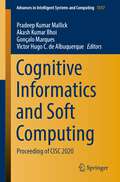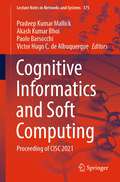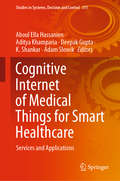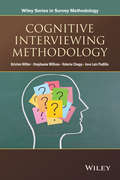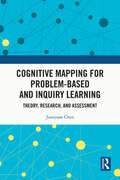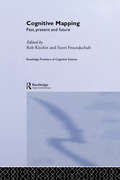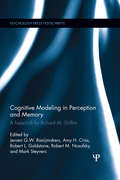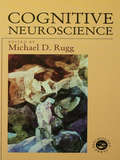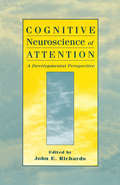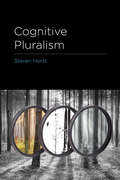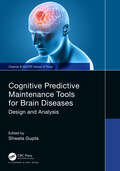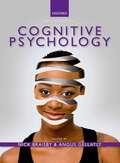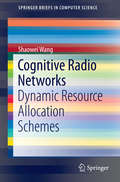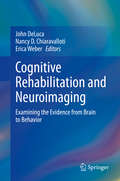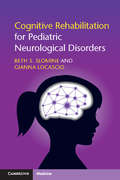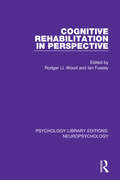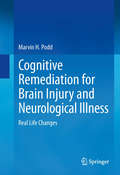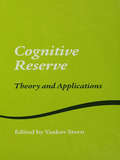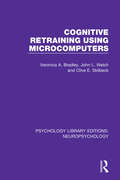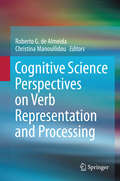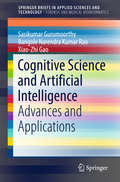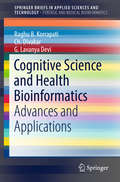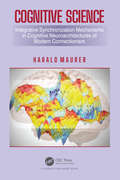- Table View
- List View
Cognitive Informatics and Soft Computing: Proceeding of CISC 2020 (Advances in Intelligent Systems and Computing #1317)
by Akash Kumar Bhoi Pradeep Kumar Mallick Victor Hugo C. de Albuquerque Gonçalo MarquesThis book presents best selected research papers presented at the 3rd International Conference on Cognitive Informatics and Soft Computing (CISC 2020), held at Balasore College of Engineering & Technology, Balasore, Odisha, India, from 12 to 13 December 2020. It highlights, in particular, innovative research in the fields of cognitive informatics, cognitive computing, computational intelligence, advanced computing, and hybrid intelligent models and applications. New algorithms and methods in a variety of fields are presented, together with solution-based approaches. The topics addressed include various theoretical aspects and applications of computer science, artificial intelligence, cybernetics, automation control theory, and software engineering.
Cognitive Informatics and Soft Computing: Proceeding of CISC 2021 (Lecture Notes in Networks and Systems #375)
by Akash Kumar Bhoi Pradeep Kumar Mallick Victor Hugo C. de Albuquerque Paolo BarsocchiThis book presents best selected research papers presented at the 4th International Conference on Cognitive Informatics and Soft Computing (CISC 2021), held at Balasore College of Engineering & Technology, Balasore, Odisha, India, from 21–22 August 2021. It highlights, in particular, innovative research in the fields of cognitive informatics, cognitive computing, computational intelligence, advanced computing, and hybrid intelligent models and applications. New algorithms and methods in a variety of fields are presented, together with solution-based approaches. The topics addressed include various theoretical aspects and applications of computer science, artificial intelligence, cybernetics, automation control theory, and software engineering.
Cognitive Internet of Medical Things for Smart Healthcare: Services and Applications (Studies in Systems, Decision and Control #311)
by Aboul Ella Hassanien Deepak Gupta K. Shankar Adam Slowik Aditya KhampariaThis book aims to provide a detailed understanding of IoMT-supported applications while engaging premium smart computing methods and improved algorithms in the field of computer science. It contains thirteen chapters discussing various applications under the umbrella of the Internet of Medical Things. These applications geared towards IoMT cloud analysis, machine learning, computer vision and deep learning have enabled the evaluation of the proposed solutions.
Cognitive Interviewing Methodology
by Kristen Miller Jose Luis Padilla Stephanie Willson Valerie CheppAN INTERDISCIPLINARY PERSPECTIVE TO THE EVOLUTION OF THEORY AND METHODOLOGY WITHIN COGNITIVE INTERVIEW PROCESSESProviding a comprehensive approach to cognitive interviewing in the field of survey methodology, Cognitive Interviewing Methodology delivers a clear guide that draws upon modern, cutting-edge research from a variety of fields.Each chapter begins by summarizing the prevailing paradigms that currently dominate the field of cognitive interviewing. Then underlying theoretical foundations are presented, which supplies readers with the necessary background to understand newly-evolving techniques in the field. The theories lead into developed and practiced methods by leading practitioners, researchers, and/or academics. Finally, the edited guide lays out the limitations of cognitive interviewing studies and explores the benefits of cognitive interviewing with other methodological approaches. With a primary focus on question evaluation, Cognitive Interviewing Methodology also includes: Step-by-step procedures for conducting cognitive interviewing studies, which includes the various aspects of data collection, questionnaire design, and data interpretation Newly developed tools to benefit cognitive interviewing studies as well as the field of question evaluation, such as Q-Notes, a data entry and analysis software application, and Q-Bank, an online resource that houses question evaluation studies A unique method for questionnaire designers, survey managers, and data users to analyze, present, and document survey data results from a cognitive interviewing study An excellent reference for survey researchers and practitioners in the social sciences who utilize cognitive interviewing techniques in their everyday work, Cognitive Interviewing Methodology is also a useful supplement for courses on survey methods at the upper-undergraduate and graduate-level.
Cognitive Mapping for Problem-based and Inquiry Learning: Theory, Research, and Assessment
by Juanjuan ChenThis book studies how to improve problem-based and inquiry-based learning by incorporating cognitive maps. Problem-based learning and cognitive mapping are reviewed from the perspective of both learning sciences and cognitive sciences, including the underpinning theories of experiential learning, situated learning, collaborative learning, meaningful learning, externalized representations and visual representations. The result is a comprehensive review and analysis of cognitive mapping-supported problem-based learning, with the topic discussed from cognitive, meta-cognitive, social, and motivational and emotional perspectives. Furthermore, the author presents a theory-driven design, implementation, and analysis of design-based research to improve problem-based learning using cognitive mapping. The book will provide implications for researchers and practitioners of learning sciences, psychology, instructional systems, and cognitive tools.
Cognitive Mapping: Past, Present and Future (Frontiers of Cognitive Science)
by Rob Kitchin and Scott FreundschuhThis important work brings together international academics from a variety of disciplines to explore the topic of spatial cognition on a 'geographic' scale. It provides an overview of the historical origins of the subject, a description of current debates and suggests directions for future research.
Cognitive Modeling in Perception and Memory: A Festschrift for Richard M. Shiffrin (Psychology Press Festschrift Series)
by Mark Steyvers Jeroen G.W. Raaijmakers Amy H. Criss Robert L. Goldstone Robert M. NosofskyThe work of Richard M. Shiffrin has highly impacted the field of cognitive science, and current developments within perception and memory have been influenced by his ideas. In this volume, several key figures in the field will comment on these developments and put them in a wider perspective. Although many theories and models have been presented in recent years for various aspects of human cognition, there have not been many comparative evaluations that focus on how these models have really advanced our understanding of the underlying mechanisms. This volume will be a valuable source of information for both cognitive scientists working in the field, and researchers and students looking for a clear, accessible presentation of the key problems in cognitive science. Highlighted sections include attention and perception, memory functions and processes, knowledge representation and semantics, modelling approaches and applications.
Cognitive Neuroscience (Studies in Cognition)
by Michael D. RuggProviding up-to-date and authoritative coverage of key topics in the new discipline of cognitive neuroscience, this book will be essential reading in cognitive psychology, neuropsychology and neurophysiology. Striking a balance between theoretical and empirical approaches to the question of how cognition is supported by the brain, it presents the major experimental methods employed by cognitive neuroscientists and covers a representative range of the subjects currently exciting interest in the field. The nine chapters of the book have been written by leading authorities in their fields. The individual chapters provide "state-of-the-art" reviews of their respective attempts to build bridges between domains of enquiry that, until quite recently, were largely independent of one another. The chapters include two describing the different methods that are now available for non-invasive measurement of human brain activity; another two that discuss various current theoretical approaches to the problem of how information is coded in the nervous system; and single contributions dealing with the neural mechanisms of long-term memory and of movement, the functional and neural architecture of working memory, the organization of language in the brain, and the relationship between perception and consciousness.Cognitive Neuroscience will appeal to advanced undergraduate and graduate students interested in the relationship between the brain and higher mental functions, as well as to established researchers in cognitive neuroscience and related fields.
Cognitive Neuroscience of Attention: A Developmental Perspective
by John E. RichardsThis volume describes research and theory concerning the cognitive neuroscience of attention. Filling a key gap, it emphasizes developmental changes that occur in the brain-attention relationship in infants, children, and throughout the lifespan and reviews the literature on attention, development, and underlying neural systems in a comprehensive manner. Special features include: * a new model of the neural control of eye movements; * a developmental perspective on the burgeoning literature on the cognitive neuroscience of attention; * the integration of ideas, research, and theories across chapters within each section via summary and commentary essays; and * a summary of the most recent work in the developmental cognitive neuroscience of attention by several of the leading researchers in this field.
Cognitive Neuroscience of Natural Language Use
by Roel M. WillemsWhen we think of everyday language use, the first things that come to mind include colloquial conversations, reading and writing e-mails, sending text messages or reading a book. But can we study the brain basis of language as we use it in our daily lives? As a topic of study, the cognitive neuroscience of language is far removed from these language-in-use examples. However, recent developments in research and technology have made studying the neural underpinnings of naturally occurring language much more feasible. In this book a range of international experts provide a state-of-the-art overview of current approaches to making the cognitive neuroscience of language more 'natural' and closer to language use as it occurs in real life. The chapters explore topics including discourse comprehension, the study of dialogue, literature comprehension and the insights gained from looking at natural speech in neuropsychology.
Cognitive Pluralism
by Steven HorstAn argument that we understand the world through many special-purpose mental models of different content domains, and an exploration of the philosophical implications.Philosophers have traditionally assumed that the basic units of knowledge and understanding are concepts, beliefs, and argumentative inferences. In Cognitive Pluralism, Steven Horst proposes that another sort of unit—a mental model of a content domain—is the fundamental unit of understanding. He argues that understanding comes not in word-sized concepts, sentence-sized beliefs, or argument-sized reasoning but in the form of idealized models and in domain-sized chunks. He argues further that this idea of “cognitive pluralism”—the claim that we understand the world through many such models of a variety of content domains—sheds light on a number of problems in philosophy.Horst first presents the “standard view” of cognitive architecture assumed in mainstream epistemology, semantics, truth theory, and theory of reasoning. He then explains the notion of a mental model as an internal surrogate that mirrors features of its target domain, and puts it in the context of ideas in psychology, philosophy of science, artificial intelligence, and theoretical cognitive science. Finally, he argues that the cognitive pluralist view not only helps to explain puzzling disunities of knowledge but also raises doubts about the feasibility of attempts to “unify” the sciences; presents a model-based account of intuitive judgments; and contends that cognitive pluralism favors a reliabilist epistemology and a “molecularist” semantics. Horst suggests that cognitive pluralism allows us to view rival epistemological and semantic theories not as direct competitors but as complementary accounts, each an idealized model of different dimensions of evaluation.
Cognitive Predictive Maintenance Tools for Brain Diseases: Design and Analysis (Chapman & Hall/CRC Internet of Things)
by Shweta GuptaThis book involves the design, analysis, and application of various cognitive predictive maintenance tests with the help of tools like vibration analysis, ultrasonic analysis, infrared analysis, oil analysis, laser-shaft alignment, and motor circuit analysis in the prediction of various cognitive diseases such as epilepsy, Parkinson’s disease, Alzheimer’s disease, and depression. These are needed since there are no proper medical tests available to predict these diseases in remote areas at an early stage. Various emerging technologies are analyzed for the design of tests. Key features: Incorporates innovative processes for treating cognitive diseases. Early and exact identification and treatment strategies are incorporated. Future technologies like artificial intelligence, machine learning, the IoT, and data science are used to find solutions. Analysis with existing cognitive disease solutions is incorporated and simulations provided. The novelty of the book lies in the accurate prediction of cognitive diseases. Encompassing future technologies and various communication protocols or devices available for cognitive diseases for the design of new equipment are an outcome of the book. Various parameters like power consumption, productivity, and safety should be taken into account during the analysis, design, and application of a product. The book could well be added to the curriculum of medical colleges and biomedical engineering students. Possible vendors include biomedical research centers like Biotechnika and the Indian Council of Medical Research (ICMR). It would be a breakthrough for biomedical companies to launch their new products.
Cognitive Psychology
by Angus Gellatly Nick BraisbyCognitive processes enable us to experience the world around us: to recognise a friendly face in a crowd, to communicate our passions, to recall memories from the past. When these processes stop working, it can turn friends into strangers, render speech impossible, and make history a confusion of truth and lies. Cognitive Psychology, Second Edition unravels these complex ideas, introducing the concepts behind them and looking at how techniques, such as neuroimaging, can provide answers to questions that may at first seem unanswerable. The chapters - covering a broad range of topics, including attention, perception, and neuropsychiatry - are written to inspire students, and come complete with helpful resources, including in-chapter summaries to consolidate learning, 'Activity' boxes to help students engage in the content, and 'Research study' boxes to encourage an awareness of scientific method. With chapters written by experts in their fields and edited by professors with a wealth of experience in teaching and learning, Cognitive Psychology, Second Edition is the ideal course companion for all psychology students.
Cognitive Radio Networks: Dynamic Resource Allocation Schemes (SpringerBriefs in Computer Science)
by Shaowei WangThis SpringerBrief presents a survey of dynamic resource allocation schemes in Cognitive Radio (CR) Systems, focusing on the spectral-efficiency and energy-efficiency in wireless networks. It also introduces a variety of dynamic resource allocation schemes for CR networks and provides a concise introduction of the landscape of CR technology. The author covers in detail the dynamic resource allocation problem for the motivations and challenges in CR systems. The Spectral- and Energy-Efficient resource allocation schemes are comprehensively investigated, including new insights into the trade-offs for operating strategies. Promising research directions on dynamic resource management for CR and the applications in other wireless communication systems are also discussed. Cognitive Radio Networks: Dynamic Resource Allocation Schemes targets computer scientists and engineers working in wireless communications. Advanced-level students in computer science and electrical engineering will also find this brief useful reading about the next generation of wireless communication.
Cognitive Rehabilitation and Neuroimaging: Examining the Evidence from Brain to Behavior
by Nancy D. Chiaravalloti John DeLuca Erica WeberThe purpose of this book is to educate readers regarding the efficacy of cognitive rehabilitation across a variety of neurological conditions, with specific emphasis on rehabilitation-related change detectable via neuroimaging. For ease of reference, this information is divided into separate chapters by neurological condition, since the nature of cognitive impairment and mechanism of rehabilitation may differ across populations. Also included are discussions of the use of neuroimaging in cognitive rehabilitation trials, rigorous design of cognitive rehabilitation trials to have greater scientific impact (e.g., obtaining Class I evidence), and future directions for the field. As such, the book is designed to be useful to both clinicians and researchers involved in the rehabilitation of such conditions so that they can make informed decisions regarding evidence-based treatment to deploy in clinical settings or to further study in research endeavors.
Cognitive Rehabilitation for Pediatric Neurological Disorders
by Gianna Locascio Beth S. SlomineResponding to expansion in the field of cognitive rehabilitation, this book offers a comprehensive review of interventions specifically for children and adolescents. Recent advances in research into pediatric cognitive rehabilitation make this a timely guide to the subject. Incorporating and reviewing current evidence to strengthen and consolidate the resource base for pediatric clinical care in cognitive rehabilitation, this book offers a reliable and engaging text for best practice. Systematic interventions to ameliorate the impact of cognitive difficulties following neurological injury, such as traumatic brain injury (TBI), stroke and brain tumor, can involve cognitive, behavioral, or pharmacologic methods. Case studies and practical guidance are included, to support the effective management and enhancement of cognitive recovery in children and adolescents. This book acts as a resource for professionals of all disciplines interested in understanding the existing evidence base for cognitive rehabilitation interventions for children and adolescents, featuring practical day-to-day professional support.
Cognitive Rehabilitation in Perspective (Psychology Library Editions: Neuropsychology #12)
by Rodger Ll. Wood Ian FusseyOriginally published in 1990, this book constitutes an objective evaluation of different cognitive rehabilitation techniques in relation to different types of brain injury at different stages of recovery. Various forms of cognitive rehabilitation are reviewed and clinical techniques are evaluated on the basis of their ability to restore functional independence or produce behaviour change, and improve aspects of cognitive ability.
Cognitive Remediation for Brain Injury and Neurological Illness: Real Life Changes
by Marvin H PoddThe purpose of this book is to teach psychologists with a neuropsychology background about cognitive remediation, the evidence in the research literature, and how to develop and conduct a treatment plan and evaluate the effectiveness of the interventions. The approach is illustrated using the computer-assisted cognitive remediation program developed by the author (NeurXercise). Twenty-nine different cases are presented in depth, following the outline presented in the earlier portions of the book. Treatment planning emphasizes Luria's concepts of alternate functional systems and double dissociation. Pre- and post-treatment neuropsychological testing results are presented along with ecological validity and generalization to daily functioning. The cases are presented by etiology and each section concludes with what can be learned about that etiologic process from the cognitive remediation results. This section includes blast injuries, which are still being characterized in the literature, as well as effective treatment of patients with head injury, stroke, post-neurosurgical sequelae, co-morbid disorders, subcortical disorders, attention deficit disorder, and learning disabilities. The book identifies the most commonly used neuropsychological test instruments for evaluating cognitive deficits, discusses their input and output characteristics, and does the same for the NeurXercise computer-based exercises so that the connection between testing and treatment is easy to see and develop. In addition to discussing this in the appropriate sections of the book, these are summarized in the appendixes as a reference for correlating test findings and appropriate exercises for remediating deficits.
Cognitive Reserve: Theory and Applications (Studies on Neuropsychology, Neurology and Cognition)
by Yaakov SternCognitive reserve has emerged as a powerful concept for interpreting individual differences in susceptibility to, and recovery from, brain injury or pathology. Underlying cognitive reserve is the idea that individual differences in how cognitive tasks are mediated in the brain allow some people to cope with pathology to a greater degree than others. Cognitive Reserve: Theory and Applications describes in depth the source of these individual differences. This volume provides a comprehensive review of theory, research and clinical application of the cognitive reserve. Chapters explore the theoretical underpinnings of cognitive reserve, and evidence for its existence. Various approaches for studying this concept are addressed, including epidemiologic, cognitive experimental, and neuroimaging. Possible genetic and physiologic underpinnings of cognitive reserve are presented. Application of this concept to a wide range of situations, including child development, aging, Alzheimer’s disease, stroke, HIV, and head injury is discussed. The result is an up-to-date, global treatment of cognitive reserve that will be of interest to someone new to the concept or the experienced investigator.
Cognitive Retraining Using Microcomputers (Psychology Library Editions: Neuropsychology #1)
by Veronica A. Bradley John L. Welch Clive E. SkilbeckOriginally published in 1993, the previous decade had seen considerable development in the field of neuropsychological rehabilitation following brain damage, and the use of computerized methods attracted attention and stimulated controversy. This practically-oriented text reviews representative examples from the literature at the time relating to the training of cognitive systems with the emphasis on studies describing the use of computerized methods. The topic is discussed in context and the contents include sections on cognitive change in neurological disorders, assessment techniques, the interaction between cognition and behaviour and the advantages and disadvantages of the use of microcomputers. The authors describe the evaluation of a computerized cognitive retraining programme run at the Regional Neurological Centre in Newcastle-upon-Tyne and draw on their experience of running such programmes to give practical guidance to those wishing to set up cognitive retraining programmes.
Cognitive Science 2nd Edition
by José Luis BermúdezThis exciting textbook introduces students to the dynamic vibrant area of Cognitive Science - the scientific study of the mind and cognition. Cognitive Science draws upon many academic disciplines, including Psychology, Computer Science, Philosophy, Linguistics and Neuroscience. This is the first textbook to present a unified view of Cognitive Science as a discipline in its own right, with a distinctive approach to studying the mind. Students are introduced to the cognitive scientist's 'toolkit' - the vast range of techniques and tools that cognitive scientists can use to study the mind. The book presents the main theoretical models that cognitive scientists are currently using, and shows how those models are being applied to unlock the mysteries of the human mind. Cognitive Science is replete with examples, illustrations, and applications, and draws on cutting-edge research and new developments to explore both the achievements that cognitive scientists have made, and the challenges that lie ahead.
Cognitive Science Perspectives on Verb Representation and Processing
by Roberto G. de Almeida Christina ManouilidouVerbs play an important role in how events, states and other "happenings" are mentally represented and how they are expressed in natural language. Besides their central role in linguistics, verbs have long been prominent topics of research in analytic philosophy--mostly on the nature of events and predicate-argument structure--and a topic of empirical investigation in psycholinguistics, mostly on argument structure and its role in sentence comprehension. More recently, the representation of verb meaning has been gaining momentum as a topic of research in other cognitive science branches, notably neuroscience and the psychology of concepts. The present volume is an expression of this recent surge in the investigation of verb structure and meaning from the interdisciplinary perspective of cognitive science, with up-to-date contributions by theoretical linguists, philosophers, psycholinguists and neuroscientists. The volume presents new theoretical and empirical studies on how verb structure and verb meaning are represented, how they are processed during language comprehension, how they are acquired, and how they are neurologically implemented. Cognitive Science Perspectives on Verb Representation and Processing is a reflection of the recent collaboration between the disciplines that constitute cognitive science, bringing new empirical data and theoretical insights on a key element of natural language and conceptualization.
Cognitive Science and Artificial Intelligence: Advances and Applications (SpringerBriefs in Applied Sciences and Technology)
by Xiao-Zhi Gao Sasikumar Gurumoorthy Bangole Narendra Kumar RaoThis book presents interdisciplinary research on cognition, mind and behavior from an information processing perspective. It includes chapters on Artificial Intelligence, Decision Support Systems, Machine Learning, Data Mining and Support Vector Machines, chiefly with regard to the data obtained and analyzed in Medical Informatics, Bioinformatics and related disciplines. The book reflects the state-of-the-art in Artificial Intelligence and Cognitive Science, and covers theory, algorithms, numerical simulation, error and uncertainty analysis, as well novel applications of new processing techniques in Biomedical Informatics, Computer Science and its applied areas. As such, it offers a valuable resource for students and researchers from the fields of Computer Science and Engineering in Medicine and Biology.
Cognitive Science and Health Bioinformatics: Advances and Applications (SpringerBriefs in Applied Sciences and Technology)
by Raghu B. Korrapati Ch. Divakar G. Lavanya DeviThis book highlights the interdisciplinary study of cognition, mind and behavior from an information processing perspective, and describes related applications to health informatics. The respective chapters address health problem-solving and education, decision support systems, user-centered interfaces, and the design and use of controlled medical terminologies. Reflecting cutting-edge research on computational methods - including theory, algorithms, numerical simulation, error and uncertainty analysis, and their applications - the book offers a valuable resource for doctoral students and researchers in the fields of Computer Science and Engineering.
Cognitive Science: Integrative Synchronization Mechanisms in Cognitive Neuroarchitectures of Modern Connectionism
by Harald MaurerThe Mind and Brain are usually considered as one and the same nonlinear, complex dynamical system, in which information processing can be described with vector and tensor transformations and with attractors in multidimensional state spaces. Thus, an internal neurocognitive representation concept consists of a dynamical process which filters out statistical prototypes from the sensorial information in terms of coherent and adaptive n-dimensional vector fields. These prototypes serve as a basis for dynamic, probabilistic predictions or probabilistic hypotheses on prospective new data (see the recently introduced approach of "predictive coding" in neurophilosophy). Furthermore, the phenomenon of sensory and language cognition would thus be based on a multitude of self-regulatory complex dynamics of synchronous self-organization mechanisms, in other words, an emergent "flux equilibrium process" ("steady state") of the total collective and coherent neural activity resulting from the oscillatory actions of neuronal assemblies. In perception it is shown how sensory object informations, like the object color or the object form, can be dynamically related together or can be integrated to a neurally based representation of this perceptual object by means of a synchronization mechanism ("feature binding"). In language processing it is shown how semantic concepts and syntactic roles can be dynamically related together or can be integrated to neurally based systematic and compositional connectionist representations by means of a synchronization mechanism ("variable binding") solving the Fodor-Pylyshyn-Challenge. Since the systemtheoretical connectionism has succeeded in modeling the sensory objects in perception as well as systematic and compositional representations in language processing with this vector- and oscillation-based representation format, a new, convincing theory of neurocognition has been developed, which bridges the neuronal and the cognitive analysis level. The book describes how elementary neuronal information is combined in perception and language, so it becomes clear how the brain processes this information to enable basic cognitive performance of the humans.
